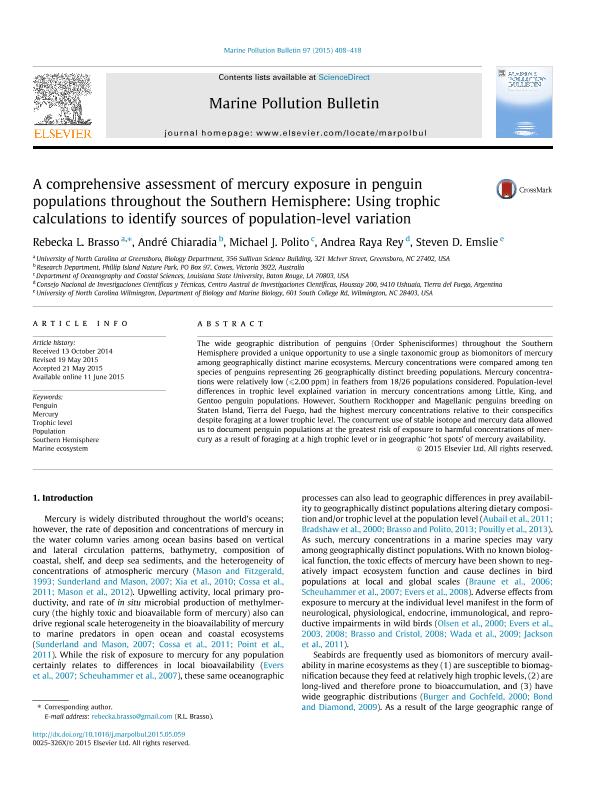Mostrar el registro sencillo del ítem
dc.contributor.author
Brasso, Rebecka L.
dc.contributor.author
Chiaradia, André
dc.contributor.author
Polito, Michael J.
dc.contributor.author
Raya Rey, Andrea Nélida

dc.contributor.author
Emslie, Steven D.
dc.date.available
2016-12-02T21:43:44Z
dc.date.issued
2015-08
dc.identifier.citation
Brasso, Rebecka L.; Chiaradia, André; Polito, Michael J.; Raya Rey, Andrea Nélida; Emslie, Steven D.; A comprehensive assessment of mercury exposure in penguin populations throughout the Southern Hemisphere: using trophic calculations to identify sources of population-level variation; Elsevier; Marine Pollution Bulletin; 97; 1-2; 8-2015; 408-418
dc.identifier.issn
0025-326X
dc.identifier.uri
http://hdl.handle.net/11336/8748
dc.description.abstract
The wide geographic distribution of penguins (Order Sphenisciformes) throughout the Southern Hemisphere provided a unique opportunity to use a single taxonomic group as biomonitors of mercury among geographically distinct marine ecosystems. Mercury concentrations were compared among ten species of penguins representing 26 geographically distinct breeding populations. Mercury concentrations were relatively low (62.00 ppm) in feathers from 18/26 populations considered. Population-level differences in trophic level explained variation in mercury concentrations among Little, King, and Gentoo penguin populations. However, Southern Rockhopper and Magellanic penguins breeding on Staten Island, Tierra del Fuego, had the highest mercury concentrations relative to their conspecifics despite foraging at a lower trophic level. The concurrent use of stable isotope and mercury data allowed us to document penguin populations at the greatest risk of exposure to harmful concentrations of mercury as a result of foraging at a high trophic level or in geographic ‘hot spots’ of mercury availability.
dc.format
application/pdf
dc.language.iso
eng
dc.publisher
Elsevier

dc.rights
info:eu-repo/semantics/openAccess
dc.rights.uri
https://creativecommons.org/licenses/by-nc-nd/2.5/ar/
dc.subject
Penguin
dc.subject
Mercury
dc.subject
Trophic Level
dc.subject
Population
dc.subject
Southern Hemisphere
dc.subject
Marine Ecosystem
dc.subject.classification
Ecología

dc.subject.classification
Ciencias Biológicas

dc.subject.classification
CIENCIAS NATURALES Y EXACTAS

dc.title
A comprehensive assessment of mercury exposure in penguin populations throughout the Southern Hemisphere: using trophic calculations to identify sources of population-level variation
dc.type
info:eu-repo/semantics/article
dc.type
info:ar-repo/semantics/artículo
dc.type
info:eu-repo/semantics/publishedVersion
dc.date.updated
2016-12-01T19:55:13Z
dc.journal.volume
97
dc.journal.number
1-2
dc.journal.pagination
408-418
dc.journal.pais
Estados Unidos

dc.description.fil
Fil: Brasso, Rebecka L.. University Of North Carolina; Estados Unidos
dc.description.fil
Fil: Chiaradia, André. Philip Island Nature Park, Research Department; Australia
dc.description.fil
Fil: Polito, Michael J.. State University Of Louisiana; Estados Unidos
dc.description.fil
Fil: Raya Rey, Andrea Nélida. Consejo Nacional de Investigaciones Científicas y Técnicas. Centro Austral de Investigaciones Científicas; Argentina
dc.description.fil
Fil: Emslie, Steven D.. University Of North Carolina; Estados Unidos
dc.journal.title
Marine Pollution Bulletin

dc.relation.alternativeid
info:eu-repo/semantics/altIdentifier/url/http://www.sciencedirect.com/science/article/pii/S0025326X15003392
dc.relation.alternativeid
info:eu-repo/semantics/altIdentifier/doi/http://dx.doi.org/10.1016/j.marpolbul.2015.05.059
Archivos asociados
